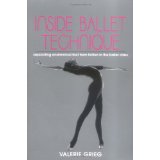You know you're going to be really sore after that first class.
New school books have their own smell and feel. New or old ballet shoes and pointe shoes have a smell, leather and satin, as does an old dance bag.
Your favorite cologne, your leotards and tights with fresh fabric softener smell...legwarmers, .....all this brings back the memories from last session, the last exam, the last performance.
And now you are starting all over again.
Take a deep breath and let yourself become aware of the goals you have for this session. Thinking in terms of two categories, your physique, which has things you want to improve, and your technique.
Physique improvements are gradual and ongoing. Flexibility and strength are lifelong goals.
Technical points also are related to physique, but not all of them. Knowing the mechanics, the correct anatomy of technical moves and ballet positions takes the mystique out of them. You can understand whether you need to work on your actual physical limitations (like tight joints) or whether you just need correct repetition.
A favorite mystique-kill book of mine:
Inside Ballet Technique: Separating anatomical fact from fiction in the ballet class.
Correct is the key word. Many ballet DVDs show a student at the barre doing excellent work, for example. And yet I see some finer points that the teacher is not correcting, which would lead to injury.
An example, watching a student's heels slide forward on the floor in a demi plie, before doing a releve onto pointe into a pirouette. That is something that should have been fixed years before doing pirouettes in pointe shoes.
The depth of the demi plie is not being used for a strong push up from the heels. Also the heels are sliding forward, which can pull at the knee joints. That kind of technical inaccuracy is worrying to look at.
Professional manuals that discuss anatomy, mechanics, in relation to ballet, can solve any unexplained questions as to which style of ballet is more technically correct. The correct way is the one that does not compromise human anatomy to the degree that joints get damaged.
A favorite of mine on turnout:
Understanding your physique, what can and cannot be changed, is half your work.
So enjoy your nervous anticipation as you go back to school for ballet and other dancing. You have a new year to look forward to.



